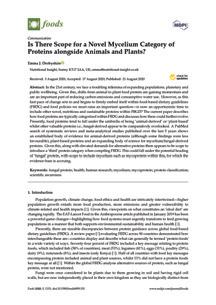
2 minute read
it Made? Nutritional Profile:
from my coprotein flyer
by QuornPro
Mycoprotein is made by fermentation of the naturally occurring fungus Fusarium venenatum and replicates the taste and texture of meat - providing us with a great tasting meat alternative, meaning we don’t have to miss out on the meals we love.
We use the age-old method of fermentation, but on a large scale – in tall, highly specialised fermenters, similar to what you would find in a brewery. These fermenters are 30 metres tall and produce continuously for 5 weeks at a time. This produces a mycoprotein paste, or ‘dough’ which is then seasoned and mixed with a little free-range egg, or plant protein in vegan products, to help bind the mix. It is then steam cooked, chilled and frozen which gives it its meat-like texture.
Fibre
Mycoprotein is an excellent source of fibre at 6g of fibre per 100g. This is classified by the European Food Safety Authority (EFSA) as ‘high in fibre’. In particular, mycoprotein includes a unique combinator of soluble and insoluble fibres called Beta-glucan and Chitin, respectively. In the UK, it is recommended that we aim to eat at least 30g of fibre per day. However, currently on average we are only eating around 18g per day!
Eating plenty of fibre is associated with a lower risk of heart disease, stroke, type 2 diabetes and bowel cancer.
Protein
Mycoprotein is a great source of protein as it contains all 9 essential amino acids, making it comparable to ‘traditional’ protein sources such as meat or fish. These are called ‘essential’ amino acids as we cannot make them in the body and therefore, must consume via our diet.
Mycoprotein also possesses a high PDCAAS (protein digestibility XYZ) of 0.99. This is in comparison to beef at 0.92. PDCAAS is a method of evaluating the quality of a protein based on both the amino acid requirements of humans and their ability to digest it – the highest possible score is 1.

https://www.quornnutrition.com/mycoprotein/what-is-mycoprotein
Fungi as a third kingdom: fungi, which also include mushrooms as well as a huge variety of micro-fungi species such as Fusarium and yeasts, are biologically distinct. Many people assume mycoprotein is plant-based but fungi do not contain cellulose or chloroplasts like plants and therefore are separate to the plant and animal kingdom. Food systems must transform to feed growing populations in a manner that both supports environmental sustainability and human health. Mycoprotein, and the recognition of fungal protein as a third food group, could support this challenge.
You can read more about this in Dr Emma Derbyshire’s paper here https://www.quorn.co.uk/company/press/quorn-protein-builds-musclebetter-than-milk-protein-study-published-in-the-AJCN
Interestingly, data published in the American Journal of Clinical Nutrition by the University of Exeter found that mycoprotein can stimulate postexercise muscle building to a greater extent than milk protein. You can read more about these findings here.
Fat
Too much fat in your diet, especially saturated fats, can raise your cholesterol, increasing the risk of heart disease. Mycoprotein is low in total fat and saturated fat. To put this into context, frozen Quorn Mince (per 100g) contains 2g of total fat and 0.5g of saturated fat compared to Beef Mince, which contains 16.2g of total fat and 6.9g of saturated fat.


